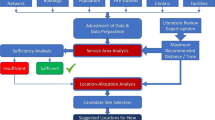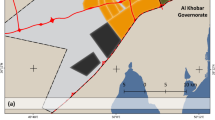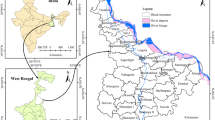Abstract
The present study aimed to assess the spatial distribution of the services of the Civil Defence Centres in Karak. The study explores the planning needs of those centres. The study makes suggestions for improving the performance efficiency of those centres. Such suggestions include establishing new facilities. The study uses location allocation models in the network analyst tool in the ArcGIS software as a proposed strategy to improve the spatial planning of urban services in Karak province. The management of the centres in these models can identify the areas which show the greatest demand for services. The study conducts spatial analysis to identify the number of inhabited blocks that are under the service coverage of each centre. The distance between each centre and the inhabited block that is under service coverage should not exceed 7 min of driving. The study finds that there are 88 inhabited blocks in Karak that are under the service coverage of a Civil Defence Centre. There are 23 inhabited blocks in Karak that are not under the service coverage of a Civil Defence Centre. The study recommends creating ten new Civil Defence Centres in order to ensure that 109 out of the 111 inhabited blocks in Karak are under the service coverage of a centre. In other words, these blocks would be provided with services within a duration that does not exceed 7 min of driving.















Similar content being viewed by others
References
Alaeddinne, E. (2012). Emergency Management Systems Using GIS (Geographic Information Systems) in Gaza City-Palestine. International Journal of Engineering and Innovative Technology, 2(6), 377–385.
Alfakhry, A., Ali, T., & Matloub, F. (2010). The Efficiency of the Spatial Distribution of Civil Defense Stations in Mosul City. Journal Al-Rafidain Engineering, 18(6), 61–104.
Al-Falahi, A. (2013). Modeling the distribution of primary schools in the city of Fallujah, using Geographic Information Systems. Journal of Planning and Development, 18(1), 175–194.
Al-Kharoof, R., Hazimeh, K., & Al-Momani, M. (2018). Analysis of the Reality of Civil Defense Services in Ajloun Governorate - Jordan. Using Geographic Information Systems, Al-Manar Journal, 24(2), 251–266.
Al-Mashrafawi, O,. Al-Kenani, S,. (2019). A study of the efficiency of the spatial distribution of civil defense centers using geographic information systems, Medad Al-Adab Journal, a special issue for conferences 2018–2019.
Ayasrah, T. (2017). Applying GIS by Location-Allocation Models for Improvement Spatial Planning of Civil Defence Servces: Case Study Jarash Governorate. Jordan, Jordan Journal of Social Sciences, 10(1), 39–64.
Church, R., & Revelle, C. (1974). The covering location problem. Papers of the Regional Science Association., 32(1), 101–118. https://doi.org/10.1007/BF01942293
Department of General Statistics. (2020). Population Estimates.
Directorate General of Civil Defense. (2018) Annual Report.
ESRI. (2020). Location - allocation analysis. Retreived on12 - February 2020 from: https://desktop.arcgis.com/en/arcmap/latest/extensions/network-analyst/locationallocation.htm
Gustavo, B. (2013), Location–allocation models applied to urban public services. Spatial analysis of Primary Health Care Centers in the city of Luján. Argentina, Hungarian Geographical Bulletin, 62(4), 387–408.
Habibi, K., Lotfi, S., & Koohsari, M. (2008). Spatial analysis of urban fire station locations by integrating AHP Model and IQ logic using GIS. (A case study of zone 6 of Tehran). Journal of Applied Sciences., 8(19), 3302–3315. https://doi.org/10.3923/jas.2008.3302.3315
Hale, T. S., & Moberg, C. R. (2003). Location science research: A review. Annals of Operations Research, 123(1), 21–35. https://doi.org/10.1023/A:1026110926707
Jaber, E. K., Samha, H., & M. (2017). Spatial Planning of Civil Defense Centers in Amman City Using GIS-based Location Allocation Model, Jordan Journal of Social Sciences, 10(3), 03–64.
Qameh, H. (2016). Geographical Assessment for Distribution of the Civil Protection Centers in the City of Damanhour Using Geographic Information Systems. Annals of Arts and Social Sciences, 36(444), 10–112.
Kemboi, T. K., Waithaka, E. H. (2015). GIS Location-Allocation Model in Improving Accessibility to Health Care Facilities: A Case Study of Mt. Elgon Sub County. International Journal of Science and Research (IJSR), 4(4), 3306–3310.
Michael, L. F., & Tarjan, R. E. (1987). Fibonacci heaps and their uses in improved network optimization algorithms. Journal of the Association for Computing Machinery., 34(3), 596–615. https://doi.org/10.1145/28869.28874
Ministry of Public Works and Housing, Department of Geographic Information Systems, Road Network 2019, Amman.
Ministry of Labour. (2020). Labour Market Indicators 2015–2019.
Ministry of Tourism and Antiquities. (2020). Directorate of Studies and Information.
Mohammad, S., & Hasoon, R. (2018). Spatial Analysis of Civil Defense Centers in Al-Diwaniyah City Using Geographic Information Systems. Al-Qadisiyah Journal for Human Sciences, V, 21(4), 39–60.
Pandav, C., Sachin, K. C., Kiran, M. J., Basanta, M. S., & Prabin, K. (2016). Application of an Analytic Hierarchy Process (AHP) in the GIS interface for suitable fire site selection: A case study from Kathmandu Metropolitan City, Nepal, Socio-Economic Planning Sciences,1–12.https://doi.org/10.1016/j.seps.2015.10.001
Philippe, C., Thomas, I., Geraets, D., Goetghebeur, E., Janssens, O., Peeters, D., & Plastria, F. (2010). Locating fire stations: An integrated approach for Belgium. Socio Economic Planning Sciences., 46(2), 173–182.
Polo, G., Acosta, C. M., Ferreira, F., & Dias, R. A. (2015). Location-Allocation and Accessibility Models for Improving the Spatial Planning of Public Health Services. PLoS ONE, 10(3), 1–14. https://doi.org/10.1371/journal.pone.0119190
Ramadan, A. M., & Sulaiman, M. (2017). Evaluating the Efficiency of Spatial Distribution of Civil Defense Centers in Dammam, Saudi Arabia, using GIS. International Journal of Planning, Urban and Sustainable Development., 4(1), 1–15.
Satchet, M., Ali, A,. Khalaf. Y,. Jaber .A, Wanas, A, (2018). Assessment and Development of the Spatial Coverage of Fire Service in Nasiriyah City By Using (GIS) International Journal of Civil Engineering and Technology, 9 (7):936–947.
The Royal Jordanian Geographic Center, Map of the Administrative Divisions of the Hashemite Kingdom of Jordan for the year 2019, Amman.
Yeh, A. G. O., & Chow, M. H. (1996). An integrated GIS and location-allocation approach to public facilities planningan example of open space planning. Computers, Environment and Urban Systems, 20(4), 339–350. https://doi.org/10.1016/S0198-9715(97)00010-0
Author information
Authors and Affiliations
Corresponding author
Additional information
Publisher's Note
Springer Nature remains neutral with regard to jurisdictional claims in published maps and institutional affiliations.
Rights and permissions
About this article
Cite this article
AlFanatseh, A., Sababhi, S. Applying GIS using location allocation models for improved spatial planning of Civil Defence Services: a Case Study of the Karak Governorate, Jordan. GeoJournal 88, 691–710 (2023). https://doi.org/10.1007/s10708-022-10632-5
Accepted:
Published:
Issue Date:
DOI: https://doi.org/10.1007/s10708-022-10632-5




